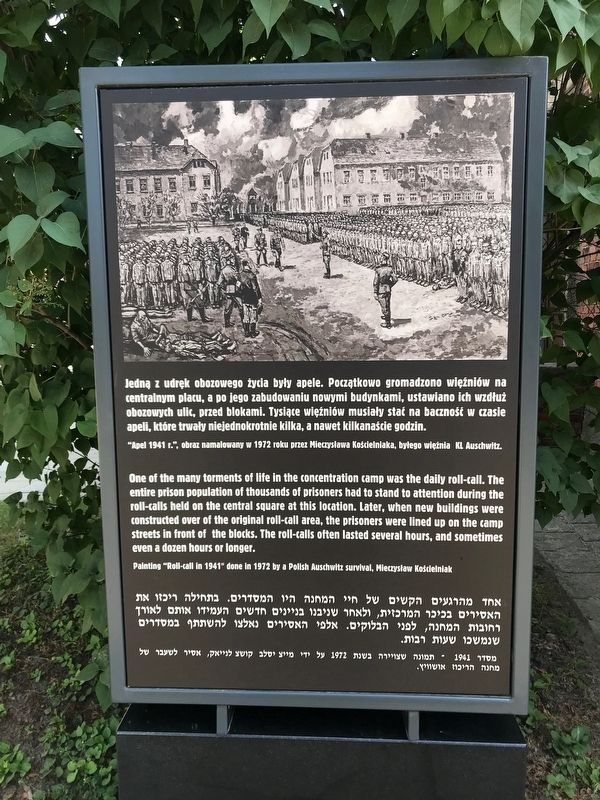Oświęcim in Oświęcim Powiat, Lesser Poland, Poland — Central Europe
The Daily Roll Call
Life in the Concentration Camp
"Apel 1941 r.", obraz namalowany w 1972 roku przez Mieczyslawa Koscielniaka, bylego wieznia KL Auschwitz.
"Apel 1941 r.", obraz namalowany w 1972 roku przez Mieczyslawa Koscielniaka, bylego wieznia KL Auschwitz.
One of the many torments of life in the concentration camp was the daily roll-call. The entire prison population of thousands of prisoners had to stand to attention during the roll-calls held on the central square at this location. Later, when new buildings were constructed over of the original roll-call area, the prisoners were lined up on the camp streets in front of the blocks. The roll-calls often lasted several hours, and sometimes even a dozen hours or longer.
Painting "Roll-Call in 1941” done in 1972 by a Polish Auschwitz survival, Mieczyslaw Koscielniak
Topics. This historical marker is listed in this topic list: War, World II. A significant historical year for this entry is 1941.
Location. 50° 1.633′ N, 19° 12.256′ E. Marker is in Oświęcim, Małopolska (Lesser Poland), in Oświęcim Powiat. Touch for map. Marker is in this post office area: Oświęcim, Małopolska 32-603, Poland. Touch for directions.
More about this marker. The marker is located on the grounds of the Memorial and Museum Auschwitz-Birkenau, on the grounds of the former barracks.
Additional commentary.
1. Best try at the Hebrew translation
One of the most difficult moments of camp life were the parades. Initially, they concentrated the prisoners in the main square, and after new buildings were built, they stood along the streets of the camp, in front of the blocks. Thousands of prisoners were forced to participate in the parades that lasted for many hours.
- A picture drawn in 1972 by Mieczysław Kościelniak, a former prisoner of the 1941 parade
אחד מהרגעים הקשים של חיי המחנה היו המסדרים. בתחילה ריכזו את
האסירים בכיכר המרכזית, ולאחר שניבנו בניינים חדשים העמידו אותם לאורך
רחובות המחנה, לפני הבלוקים. אלפי האסירים נאלצו להשתתף במסדרים
שנמשכו שעות רבות.
- תמונה שצויירה בשנת 1972 על ידי מיין יסלב קושע לנייאק, אסיר לשעבר של מסדר 1941
— Submitted September 12, 2023.
Additional keywords. Holocaust
Credits. This page was last revised on September 12, 2023. It was originally submitted on July 13, 2019, by Steve Masler of Memphis, Tennessee. This page has been viewed 168 times since then and 13 times this year. Photo 1. submitted on July 13, 2019, by Steve Masler of Memphis, Tennessee. • Andrew Ruppenstein was the editor who published this page.
